Isis Soteira; Isis as Eternal Savior
One of Isis’ epithets in the Hellenistic world was Soteira, “Savior,” or more precisely, “Savioress.”
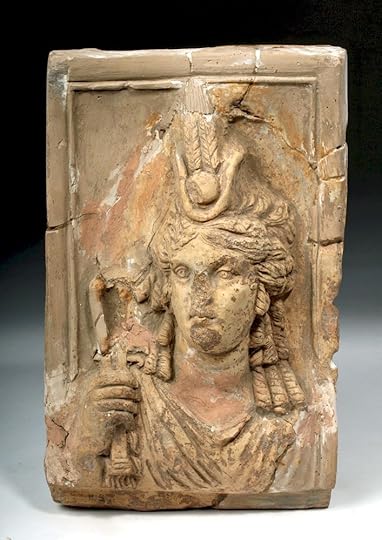 A Greco-Roman image of Isis
A Greco-Roman image of IsisIf the Christian* Deity, Jesus, is the only one with that title you’re familiar with, that epithet might feel a little weird. For some of us, it might even feel deeply uncomfortable.
So, let’s look at that.
Those of us living in a largely Christian nation are probably most familiar with the Christian concept of salvation. As a result of Jesus’ sacrifice on the cross, believing Christians can be “saved,” “forgiven,” or “redeemed” of their sins—from the “original sin” one inherits by simply being human, to the major and minor errors all human beings inevitably make. As a saved soul, after death they reside in heaven, among the angels and the good.
But many Christians also have a more worldly notion of being saved. One might consider that Jesus saved them from alcoholism. Another person might believe that Jesus saved them from being hit by a car when they accidentally walked into traffic. Some might even praise Jesus when their team wins a football game, saving them from losing, I guess.
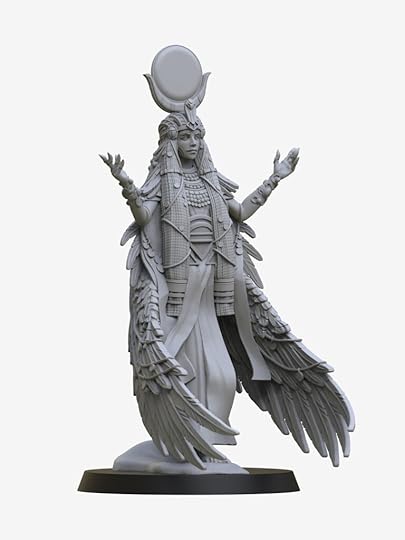 An interesting 3D model of Isis that came up when I searched “Isis the Savior.” See more of the work here.
An interesting 3D model of Isis that came up when I searched “Isis the Savior.” See more of the work here.And that’s all very human.
Prior to the formation of Christianity, this worldly type of saving was one of the ways many Pagans in the Mediterranean world viewed salvation as well. I’m skim-reading a book now about ancient Greek concepts of salvation and the many Savior Deities they worshipped—Isis among Them, of course.
We find ancient people setting up votive offerings in temples of Soteira (fem.) and Soter (masc.) Deities throughout the Hellenistic world. In Greek, soteria can mean “saving,” “preservation,” “safety,” “deliverance,” “rescue,” and similar concepts.
Votive stelae attest to people being saved from earthquakes or lightning strikes. People made offering to Deities Who cured illness. The aretalogy of Isis from Maroneia was a thank-offering given to Isis for curing a devotee’s blindness. Those who lived and worked along the shores of the Mediterranean set up stelae to the Deity Who helped them reach safe harbor after a voyage at sea. Isis Pelagia is prominent among these sea-saving Deities.
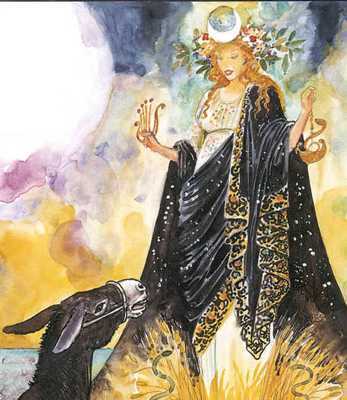 Isis appears to Lucius, pre-salvation
Isis appears to Lucius, pre-salvationBut, the ancients also understood the idea of “reaching safe harbor” metaphorically. A funerary inscription of a priest of Isis noted that, due to his service to the Goddess, he would not travel to “dark Acheron”** when he died, but would instead arrive at “the harbor of the blessed.”
Reaching such safe harbor was one of the many reasons people sought initiation into the Mystery religions of the time. People knew that Mystery initiations could bring them worldly salvation—such as a fresh start, a deeper understanding and experience of the Mystery Deities, or healing. But importantly, initiation into the Mysteries could also bring salvation in the Otherworld and lessen our natural, human fear of death.
In Apuleius’ tale of the initiation of his character, Lucius, into the Mysteries of Isis, the Goddess first saves Lucius from having been magically transformed into an ass. Then She promises that he will live his life as a happy man, and when he dies, he will pass into the Otherworld, continue to worship Her, and will dwell in the Elysian fields (roughly, “heaven”).
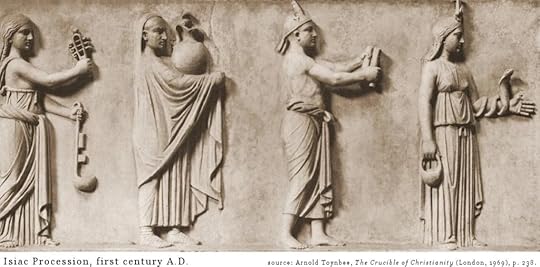
Initiates of the Mysteries of Isis also gained rebirth and spiritual regeneration while still living. Growing out of the ancient Egyptian funerary tradition of rebirth after death and merged into the Greco-Egyptian religiosophic mix of Hellenistic Egypt, the idea of spiritual regeneration became a popular notion among the votaries of Isis in the late-Pagan period. For as Lucius says, “She [Isis] caused them [Her initiates] in some way to be born again and placed them once again on the course of a new life.”
And no matter how much some folks might like to separate Greco-Roman Isis from Egyptian Isis, there is deep continuity in Her core nature; none of this “saving” was new to the character of Our Goddess.
 As She saved and renewed Osiris, so She saves all of us
As She saved and renewed Osiris, so She saves all of usIn the Egyptian Faiyum, where the Greco-Egyptian Isidorus composed his hymns to Isis in Greek, he names the Goddess as “Deathless Savior” in the early 1st century BCE.
Elsewhere in Egypt, and long before Isidorus’ time, Isis is among the many Egyptian Deities Who were perpetually concerned with regeneration, renewal, and—ideally—a reset to the perfection of First Creation, the Zep Tepi. Indeed some scholars consider all ancient Egyptian rites to be focused on these concerns.
As a Primordial Goddess, Isis was there at that perfect beginning. Isis is called “She Who was First,” an epithet found not only in Isis’ own temples, but also in the temples of other Deities. At Dendera, for instance, we learn that “all things come into being after Her” and “all things begin with Her.” Isis is a Goddess Who creates and Who then preserves what She has created through Her powerful, renewing magic. Other texts at Dendera tell us that She is the one “Who begins all good/beautiful/perfect [nofer, in Egyptian] things.” At Her Isiopolis temple in the Egyptian Delta, it is “She Who lets goodness/beauty/perfection emerge” and “She Who creates the beneficent things.”
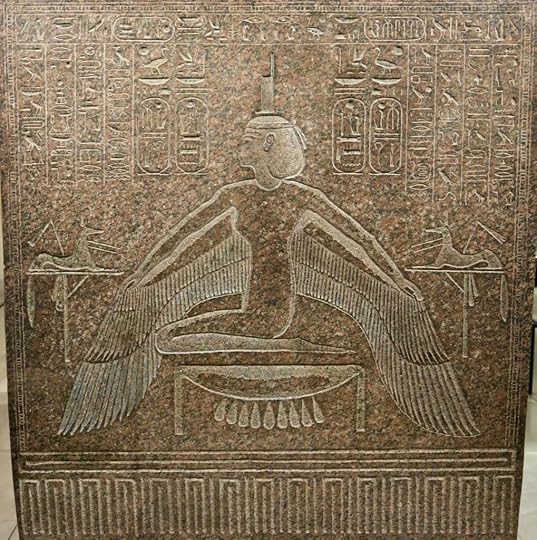 Isis spreads Her protective wings
Isis spreads Her protective wingsBecause She created beneficent things, bestowing Her beneficence to all, She is known as the one “Who hears the petitions of millions.” A graffito from Thebes advises, “O you of all lands! Call to Isis, the Great Goddess! She listens at every moment, She does never abandon the one who invokes Her in the road [that is, while traveling].” People also call out to the Goddess when they are afraid, for Isis is “She Who rescues from fright/misfortune” and “She Who saves the weak from the violent.” And, as I’m sure you already know, many invoked Her then, and many still do, to save them from illness and to promote healing of all kinds.
Isis’ beneficence extends into the funerary realm as well. She is the Queen of the Netherworld and is “at the head of the Mysterious/Secret Netherworld [“at the head” means She is the chief of that realm].” At Her small temple of Deir el-Shelwit, Isis is “She Who commands those who are in the necropolis.” And, of course, Isis is the one Who raises Osiris from the dead to become Lord of the Otherworld. When Osiris sees Isis there, welcoming Him into the land of the dead, He rejoices. In our own afterlife journeys, we, too, can rejoice when we see Her for “true is Isis, Who acted on my behalf.” We can know that She will spread Her protective wings over us as we are reborn into our new life among the Aakhu, the “Akh spirits” who are the transfigured and blessed dead. We are all under the beneficent wings of Isis, the Lady of the Otherworld, the Lady of Silence.
 Isis works Her magic to raise Osiris
Isis works Her magic to raise OsirisAs part of Her Divine Mystery, Isis is a Goddess of Eternity. Isis is “She Who engenders eternity” and “She Who brings into being everlastingness.” (For more on these two important types of ancient Egyptian eternity, see my posts here and here.)
Whether within the borders of Her homeland of Egypt, or outside of it, as Her worship spread first throughout the Mediterranean world, and then throughout the Roman Empire, Isis has always, always been a saving Goddess, a Savior Goddess, even though that specific term was not used until later.
As Isis devotees, we know that we can call on Her for help in the trials of our daily lives. We know that we can ask Her to hear us, and to help protect us, and to help heal us. And when our own lifespan is over, and we enter the Great Mystery to discover for ourselves what lies beyond, I, for one, know that I will rejoice when I see Her there, shining like holy starlight in the Otherworld, leading me on—my Soteira, my Lady of Eternity and Everlastingness, my Tana, my Isis.
How about you? Have you ever been “saved” by Isis? I’d love to hear your story.
*And some Jewish sects, such as Messianic Jews.
**One of five underworld rivers by which one crossed over to the land of the dead, thus an entrance to the land of the dead; sometimes used more broadly to refer to the entirely of the land of the dead.



